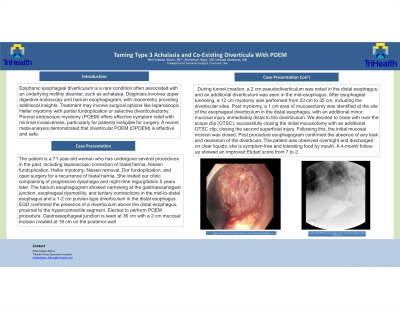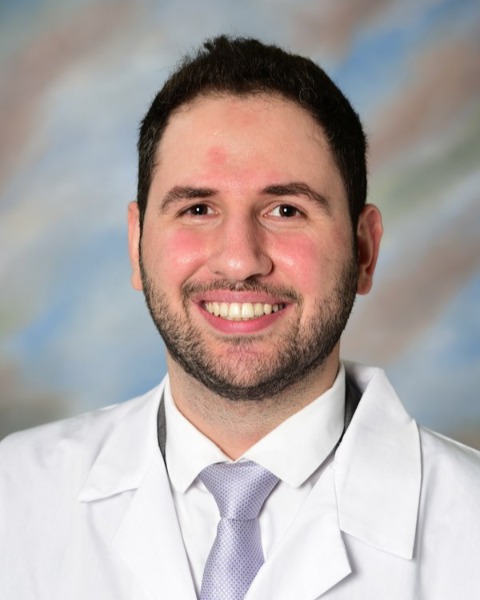Monday Poster Session
Category: Endoscopy Video Forum
P2169 - Taming Type 3 Achalasia and Co-Existing Diverticula With POEM
Monday, October 28, 2024
10:30 AM - 4:00 PM ET
Location: Exhibit Hall E

Has Audio

Mhd Kutaiba Albuni, MD
Department of Internal Medicine, TriHealth Inc., Cincinnati
Cincinnati, OH
Presenting Author(s)
Mhd Kutaiba Albuni, MD1, Mohamad Hijazi, MD1, Venkata Muddana, MD2
1TriHealth Good Samaritan Hospital, Cincinnati, OH; 2TriHealth, Cincinnati, OH
Introduction: Epiphanic esophageal diverticulum is a rare condition often associated with an underlying motility disorder, such as achalasia. Diagnosis involves upper digestive endoscopy and barium esophagogram, with manometry providing additional insights. Treatment may involve surgical options like laparoscopic Heller myotomy with partial fundoplication or selective diverticulectomy. Peroral endoscopic myotomy (POEM) offers effective symptom relief with minimal invasiveness, particularly for patients ineligible for surgery. A recent meta-analysis demonstrated that diverticular POEM (DPOEM) is effective and safe.
Case Description/Methods: The patient is a 71-year-old woman who has undergone several procedures in the past, including laparoscopic correction of hiatal hernia, Nissen fundoplication, Heller myotomy, Nissen removal, Dor fundoplication, and open surgery for a recurrence of hiatal hernia. She visited our clinic complaining of progressive dysphagia and night-time regurgitation 5 years later.<br><br>The barium esophagogram showed narrowing at the gastroesophageal junction, esophageal dysmotility, and tertiary contractions in the mid-to-distal esophagus and a 1-2 cm pulsion-type diverticulum in the distal esophagus. EGD confirmed the presence of a diverticulum above the distal esophagus, proximal to the hypercontractile segment.<br> <br>Elected to perform POEM procedure. Gastroesophageal junction is seen at 36 cm with a 2 cm mucosal incision created at 18 cm on the posterior wall. During tunnel creation, a 2 cm pseudodiverticulum was noted in the distal esophagus, and an additional diverticulum was seen in the mid-esophagus. After esophageal tunneling, a 12 cm myotomy was performed from 23 cm to 35 cm, including the diverticular sites. Post myotomy, a 1 cm area of mucosectomy was identified at the site of the esophageal diverticulum in the distal esophagus, with an additional minor mucosal injury immediately distal to the diverticulum. We decided to close with over the scope clip (OTSC), successfully closing the initial mucosotomy with an additional OTSC clip, closing the second superficial injury. Following this, the initial mucosal incision was closed. Post procedure esophagogram confirmed the absence of any leak and resolution of the diverticula. The patient was observed overnight and discharged on clear liquids; she is symptom-free and tolerating food by mouth. A 4-month follow-up showed an improved Ekdart score from 7 to 2.<br><br>
Discussion: This case demonstrates a successful POEM in this technically challenging clinical situation.
Disclosures:
Mhd Kutaiba Albuni, MD1, Mohamad Hijazi, MD1, Venkata Muddana, MD2. P2169 - Taming Type 3 Achalasia and Co-Existing Diverticula With POEM, ACG 2024 Annual Scientific Meeting Abstracts. Philadelphia, PA: American College of Gastroenterology.
1TriHealth Good Samaritan Hospital, Cincinnati, OH; 2TriHealth, Cincinnati, OH
Introduction: Epiphanic esophageal diverticulum is a rare condition often associated with an underlying motility disorder, such as achalasia. Diagnosis involves upper digestive endoscopy and barium esophagogram, with manometry providing additional insights. Treatment may involve surgical options like laparoscopic Heller myotomy with partial fundoplication or selective diverticulectomy. Peroral endoscopic myotomy (POEM) offers effective symptom relief with minimal invasiveness, particularly for patients ineligible for surgery. A recent meta-analysis demonstrated that diverticular POEM (DPOEM) is effective and safe.
Case Description/Methods: The patient is a 71-year-old woman who has undergone several procedures in the past, including laparoscopic correction of hiatal hernia, Nissen fundoplication, Heller myotomy, Nissen removal, Dor fundoplication, and open surgery for a recurrence of hiatal hernia. She visited our clinic complaining of progressive dysphagia and night-time regurgitation 5 years later.<br><br>The barium esophagogram showed narrowing at the gastroesophageal junction, esophageal dysmotility, and tertiary contractions in the mid-to-distal esophagus and a 1-2 cm pulsion-type diverticulum in the distal esophagus. EGD confirmed the presence of a diverticulum above the distal esophagus, proximal to the hypercontractile segment.<br> <br>Elected to perform POEM procedure. Gastroesophageal junction is seen at 36 cm with a 2 cm mucosal incision created at 18 cm on the posterior wall. During tunnel creation, a 2 cm pseudodiverticulum was noted in the distal esophagus, and an additional diverticulum was seen in the mid-esophagus. After esophageal tunneling, a 12 cm myotomy was performed from 23 cm to 35 cm, including the diverticular sites. Post myotomy, a 1 cm area of mucosectomy was identified at the site of the esophageal diverticulum in the distal esophagus, with an additional minor mucosal injury immediately distal to the diverticulum. We decided to close with over the scope clip (OTSC), successfully closing the initial mucosotomy with an additional OTSC clip, closing the second superficial injury. Following this, the initial mucosal incision was closed. Post procedure esophagogram confirmed the absence of any leak and resolution of the diverticula. The patient was observed overnight and discharged on clear liquids; she is symptom-free and tolerating food by mouth. A 4-month follow-up showed an improved Ekdart score from 7 to 2.<br><br>
Discussion: This case demonstrates a successful POEM in this technically challenging clinical situation.
Disclosures:
Mhd Kutaiba Albuni indicated no relevant financial relationships.
Mohamad Hijazi indicated no relevant financial relationships.
Venkata Muddana indicated no relevant financial relationships.
Mhd Kutaiba Albuni, MD1, Mohamad Hijazi, MD1, Venkata Muddana, MD2. P2169 - Taming Type 3 Achalasia and Co-Existing Diverticula With POEM, ACG 2024 Annual Scientific Meeting Abstracts. Philadelphia, PA: American College of Gastroenterology.
